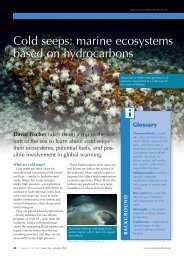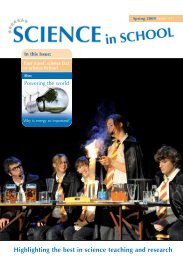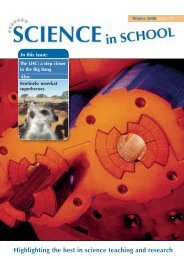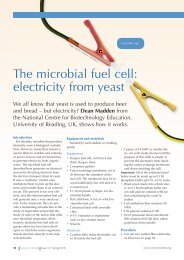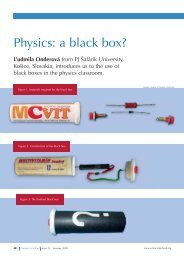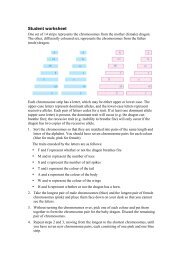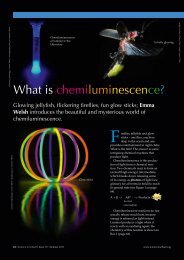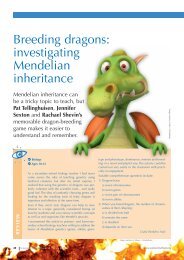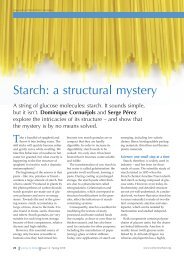Harnessing the power of the Sun: fusion reactors - Science in School
Harnessing the power of the Sun: fusion reactors - Science in School
Harnessing the power of the Sun: fusion reactors - Science in School
You also want an ePaper? Increase the reach of your titles
YUMPU automatically turns print PDFs into web optimized ePapers that Google loves.
Transmission l<strong>in</strong>e<br />
Image courtesy <strong>of</strong> EFDA<br />
Ohmic heat<strong>in</strong>g<br />
Electrical current<br />
Radio frequency<br />
heat<strong>in</strong>g<br />
Antenna<br />
Electromagnetic<br />
waves<br />
Figure 5: To achieve a plasma <strong>of</strong> 100-200<br />
million °C, three complementary heat<strong>in</strong>g<br />
systems are used: ohmic heat<strong>in</strong>g, neutral<br />
beam <strong>in</strong>jection and radio frequency heat<strong>in</strong>g<br />
Energetic<br />
hydrogen atoms<br />
Neutral beam <strong>in</strong>jection heat<strong>in</strong>g<br />
2) Heat<strong>in</strong>g<br />
To heat <strong>the</strong> plasma to 100-200 million<br />
°C, <strong>fusion</strong> scientists use three<br />
complementary systems (Figure 5).<br />
1. The plasma current produces heat<br />
(ohmic heat<strong>in</strong>g) itself – just as a<br />
wire warms up when an electric<br />
current flows through it.<br />
2. Beams <strong>of</strong> high-energy particles,<br />
usually hydrogen atoms, are<br />
<strong>in</strong>jected <strong>in</strong>to <strong>the</strong> plasma, where<br />
<strong>the</strong>y transfer <strong>the</strong>ir energy to <strong>the</strong><br />
plasma particles via collisions<br />
(th<strong>in</strong>k <strong>of</strong> a fast billiard ball hitt<strong>in</strong>g<br />
a slower ball, which <strong>the</strong>n speeds<br />
up). The particle beam is generated<br />
by accelerat<strong>in</strong>g ions with high<br />
voltage. Because charged particles<br />
cannot penetrate <strong>the</strong> magnetic<br />
field around <strong>the</strong> plasma, <strong>the</strong>y are<br />
turned <strong>in</strong>to neutral atoms before<br />
<strong>in</strong>jection.<br />
In practice, this is no easy task.<br />
To give <strong>the</strong> particles <strong>the</strong> necessary<br />
velocity, a particle accelerator<br />
relies on <strong>the</strong> attractive force that a<br />
high voltage exerts on a charged<br />
particle (or ion). However, only<br />
uncharged (neutral) particles<br />
can penetrate <strong>the</strong> magnetic field<br />
BACKGROUND<br />
Fusion energy<br />
The <strong>fusion</strong> <strong>of</strong> one tritium (T) and one deuterium (D) nucleus releases<br />
17.6 MeV <strong>of</strong> energy, 80% <strong>of</strong> which – 14.1 MeV – is carried<br />
by <strong>the</strong> neutron and can be used to produce electricity. Fus<strong>in</strong>g<br />
1 kg D with 1.5 kg T (<strong>the</strong> mass <strong>of</strong> T is 1.5 times that <strong>of</strong> D) yields<br />
14.1/(2*1.67262*10 -27 ) = 4.2*10 27 MeV, tak<strong>in</strong>g <strong>in</strong>to account that one<br />
D nucleus comprises two protons, each weigh<strong>in</strong>g 1.67262·10 -27 kg.<br />
One kilogram <strong>of</strong> D conta<strong>in</strong>s 3·10 26 nuclei (one D nucleus comprises<br />
one neutron and one proton, each weigh<strong>in</strong>g 1.6·10 -27 kg). Fus<strong>in</strong>g<br />
1 kg <strong>of</strong> D (with 1.5 kg <strong>of</strong> T, as <strong>the</strong> mass <strong>of</strong> T is 1.5 times that <strong>of</strong> D)<br />
<strong>the</strong>refore results <strong>in</strong> 3·10 26 <strong>fusion</strong> reactions and yields 14.1 x 3·10 26 =<br />
4.2 x 10 27 MeV <strong>of</strong> energy.<br />
A <strong>fusion</strong> <strong>power</strong> plant with an efficiency <strong>of</strong> 40% could generate<br />
70 GWh <strong>of</strong> electricity (with 1 eV = 1.6*10 -19 J or Ws) from 1 kg D,<br />
enough to supply 20 average households <strong>in</strong> an <strong>in</strong>dustrial country.<br />
Deuterium can be extracted from seawater, which conta<strong>in</strong>s 35 grams<br />
per cubic metre. Tritium is not found <strong>in</strong> large quantities <strong>in</strong> nature but<br />
can be obta<strong>in</strong>ed from <strong>the</strong> light metal lithium, with <strong>the</strong> aid <strong>of</strong> some <strong>of</strong><br />
<strong>the</strong> neutrons produced <strong>in</strong> <strong>the</strong> <strong>fusion</strong> reaction:<br />
6<br />
Li + n => 4 He + 3 H + energy<br />
or <strong>in</strong> a similar reaction with 7 Li. Most <strong>of</strong> Earth’s m<strong>in</strong>erals conta<strong>in</strong><br />
lithium, 2.3 kg <strong>of</strong> which yields 1 kg tritium. A <strong>fusion</strong> <strong>power</strong> plant<br />
produc<strong>in</strong>g 1 GW electricity (a capacity similar to those <strong>of</strong> nuclear<br />
fission plants) will use 150 kg T and 100 kg D per year.<br />
46 I <strong>Science</strong> <strong>in</strong> <strong>School</strong> I Issue 22 : Spr<strong>in</strong>g 2012<br />
www.science<strong>in</strong>school.org





